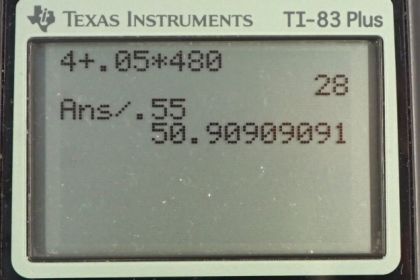Question
Freight trains can produce only relatively small accelerations and decelerations. (a) What is the final velocity of a freight train that accelerates at a rate of for 8.00 min, starting with an initial velocity of 4.00 m/s? (b) If the train can slow down at a rate of , how long will it take to come to a stop from this velocity? (c) How far will it travel in each case?
Final Answer
a)
b)
c) For part (a): . For part (b):
Solution video
OpenStax College Physics for AP® Courses, Chapter 2, Problem 29 (Problems & Exercises)

vote with a rating of
votes with an average rating of
.
Calculator Screenshots
Video Transcript
This is College Physics Answers with Shaun Dychko We begin by writing down the information the question gives us, that tells us that the freight train accelerates at a rate of .05 meters per second squared. And it's going to do so for a period of 8 minutes, which we will convert into seconds since we always want to have MKS units in our work here. We want meters, kilograms and seconds. And so, here we have minutes and we instead want seconds. So, we convert it to seconds by multiplying by 60 seconds per minute. That gives 480 seconds. And the initial velocity of this freight train is 4.0 meters per second. And so, what will the final velocity be after the 8 minutes? Well, it's going to be the initial velocity plus acceleration multiplied by time. So, that's 4.00 meters per second plus 0.0500 meters per second squared times 480 seconds, giving us 28.0 meters per second as the final velocity. Now, if the freight train comes to a stop from this velocity here of 28 meters second, with an acceleration of negative .550 meters per second squared, how long will that take? So, our definition of acceleration is that it's the difference in velocities divided by time. And we'll multiply both sides by t here because we want it to be in the numerator. We don't want it in the denominator. 't ' is the variable we are trying to solve for. And, that makes it disappear in the right, and then, it shows up on the left multiplied by a. And then, we divide both sides by the acceleration giving us t equals final velocity minus initial velocity divided by acceleration. So, that's 0 final velocity, since it comes to a stop, minus the initial velocity of 28.0 meters per second that we calculated in part A, and divide that by negative .55 meters per second squared, giving us 50.9 seconds for the train to stop. And, now in part C, we're going to find the distance traveled in each of these scenarios of Part A and B. So, in part A, we know that the final position will be the initial position plus the initial velocity times time plus one-half times acceleration times time squared. And so, that 0 plus 4.0 meters per second times 480 seconds plus one-half times .05 meters per second squared times 480 seconds whole squared. And that gives 7680 meters that the train travels when it's coming to a stop. So, you can see that the train takes a long time to stop because it takes... Or sorry. Actually, we're not stopping here, are we? No, no, no. Never mind, sorry. We're accelerating here. This is part A. Yeah. So, the train takes almost 8 kilometers to get up to speed. The freight train accelerates very slowly. Now, for part B, We're going to use a different formula because it's... it's always best practice to use as little calculated information in your work as possible. So, we could use this formula if we wanted to because we know how long it takes for the train to stop. It takes 50.9 seconds and we know the velocity that it starts with of 28.0 meters per second, but that's two quantities that we calculated and it's possible that we made a mistake in one of them. And we wouldn't want that mistake to then make our answer for this calculation wrong as well. So, we choose a formula that reduces the amount of stuff that we calculated in it. And so, we'll use this formula here, which does not use this time. It still uses the final velocity that we calculated in part A. So, we can't avoid this issue entirely, but, at least, we're using only one calculated number instead of two of them. So, we have final velocity as initial velocity plus two times acceleration multiplied by the displacement - final position minus initial position. So, we want to solve for this bracket here - this x minus x naught and we will do that by subtracting v naught squared from both sides and then switch the sides around. And it will disappear here, leaving 2a times displacement equals difference of velocity... the squares of the velocities. And then, divide both sides by 2a. It cancels there, leaving us with displacement is the difference in the squares of the velocities divided by two times acceleration. So, it comes to a stop. That means that final velocity is zero and then minus 28.0 meters per second squared divided by 2 times negative .550 meters per second squared. And then, that gives us 713 meters over which the train travels while it is stopping. So, it goes quite far when it stops and that's because it's so heavy.

